

 |
August 19-23: A Visit to Bangkok |
 |
Return to Index for 1978 |
As it turned out, I left that sense of "calmness" behind in Bangkok when I took the next leg of my Orient odyssey to the Crown Colony of Hong Kong.
Traveling from Bangkok to Hong Kong
|
My flight was early in the morning, and we arrived in Hong Kong just after noontime, counting the time difference. The first exciting thing I did in Hong Kong was to land at Kai Tak Airport.
My first views of the city were from the Singapore Airlines jet as it came in over the city, but I got to see some of Hong Kong up close and very, very personal as we came in for a landing. As you are aware, the land area of Hong Kong is fixed, and it is surrounded on all sides by presumably "hostile" territory (although that is becoming apparently less and less true). The result is an unbelievably crowded space, with one of the highest population densities of any city on the globe.
The city has grown so much that high-rise buildings have been built right up to the airport boundary, and so when flights come in to land they are literally just a few hundred feet above six-storey buildings, making Kai-Tak landings some of the world's most unnerving. (The single runway is surrounded on the other three sides by Victoria Harbor.) To land here, the pilot must make a low-altitude turning manoeuver before the shortened final approach, a turn so spectacular that passengers could spot television sets in the apartments, and the people watching them seemed (in the words of one passenger in an article written some years after my visit, "an unsettling arms length away." Steve Goldberg had cautioned me ahead of time about the landing, and so I knew what to expect, but still, the view from my window seat was indeed just a little frightening.
|
In trying to show you how I got to the Sheraton Hong Kong (where Steve had booked me), I am hampered by the fact that the aerial views and maps available to me in 2019 are hardly accurate in describing the situation as it was 40 years ago. I do recall that the airport exit was via the northwest end of the artificial peninsula on which the airport had been built, although it doesn't appear as if that access is much used today.
Hong Kong is today much larger and the buildings much taller than they were on my visit, of course, but I remember the taxi ride pretty much paralleling the harbor as we headed southwest to the center of Hong Kong.
I took but one picture on my way into the city, and I am not sure what prompted me to do so. Here you can see an apartment building near the north end of the airport. I guess that I thought it was interesting because instead of balconies jutting out from the building (as my own does back in Chicago), the builder here chose to angle the outer wall of each apartment to leave a little triangle where someone might put a chair or a small grill or something like that. I imagine this is cheaper than putting in the structural elements necessary to support the kind of balcony that I have.
The Sheraton Hong Kong
|
|
The aerial view at right is, of course, from 2019, and you can see that Nathan Road has, apparently, changed so that the small shops and such are gone, replaced by office buildings and hotels and more open space.
By the time I got to the hotel and checked in, it was getting on to late afternoon. I did go out and do some walking around the area, noting some of the shops that I thought I might want to check out during my stay. I returned to the hotel to put on my jogging shorts and go out for a run (which took me down to Salisbury Road which was much less crowded). Returning to the Sheraton, I got cleaned up and went out once again to get some supper (oriental food, of course). At the front desk, I inquired as to what they thought I might do in the next few days and then I retired for the night.
A Ferry Ride to Hong Kong
|
To the south, across Victoria Harbor, is Hong Kong island, and it is this area that most folks picture as Hong Kong. The island had a population of about 3,000 inhabitants scattered in a dozen fishing villages when it was occupied by the United Kingdom in the First Opium War. In 1842, the island was formally ceded in perpetuity to the UK under the Treaty of Nanking and the City of Victoria was then established on the island by the British Force in honor of Queen Victoria. The Central area on the island is the historical, political and economic center of Hong Kong. The northern coast of the island forms the southern shore of the Victoria Harbor, which is largely responsible for the development of Hong Kong due to its deep waters favoured by large trade ships.
The third area that you may have heard of is Macau. Macau is about twenty miles from Hong Kong proper on the western side of the Pearl River estuary in southern China. Macau was formerly a colony of the Portuguese Empire, after Ming China leased the territory as a trading post in 1557. Historically governing under Chinese authority and sovereignty, Portugal was given perpetual occupation rights for Macau in 1887. Along with Hong Kong and Kowloon, the future status of Macau is somewhat in doubt. Britain has a lease for Hong Kong and Kowloon that runs out in 1997, and discussions are ongoing about what will happen then. The same is true for Macau, as the Portuguese only administer the area, and the latest is that whatever happens with Hong Kong will happen with Macau as well. Macau has become a major resort city and the top destination for gambling tourism; its gaming industry is almost ten times larger than that of Las Vegas.
|
I want to say one more thing about Kowloon vs. Hong Kong. Kowloon has a different flavor from Hong Kong Island. Most of the large hotels are here, and much commercial activity is here as well. Shopping and entertainment are concentrated on the north side of Victoria Harbor here in Kowloon.
Why is this true? The answer is that buildable land area on Hong Kong Island is in very short supply. Just about every square inch of what can be built on has been built on, and, indeed, development has tried to move up the mountainsides. But in recent years, it has been found that the land on the hillsides is not stable enough for high-rises, and some years ago there were two notable building collapses when the land under two relatively new structures shifted under the weight of those structures. One (not yet fully occupied, fortunately) collapsed, and another became uninhabitable.
So if you look at the aerial view above, in the area marked as "Sheung Wan", it looks as if you are just looking at typical congested urbanity. Not exactly so. At right is an an extreme closeup view of just a few square blocks out of the hundreds in the aerial view above; you can see that the urbanization is high-rise in the extreme, with the majority of structures exceeding 40 stories. It's a lot like Manhattan; the land is so scarce that the only way to go is up. Of course, both these views are post-2015, and there were not nearly so many high-rises right now when I am here, but still, Hong Kong is an area of high-rise living and working.
|
|
Clustered around that landmark building are banks, stock firms, shipping companies, etc. The dock for the Star Ferry (also controlled by the Authority although nominally private) is directly in front.
Behind the financial and commercial towers there are residential ones, although a lot more of them have been built in the years since my visit this time. The island is home to many of the most famous sights in Hong Kong, such as "The Peak", Ocean Park, many historical sites and various large shopping centers. The mountain ranges across the island are also famous for hiking.
|
This is a typical street scene up the hillside on Hong Kong Island. Most of the building here is new, although occasionally one will spot older structures. Because these tend to be low buildings, and because land is at such a premium here, most of these have been torn down in recent years and new, higher structures erected in their place.
The day was very warm, and being surrounded by water the island is pretty humid, but it was not yet oppressive. The blue sky that I could see from the ferry earlier was gradually disappearing, the clouds thickening, and rain becoming more of a possibility. To get some good views of the city, I decided to take the tramway to the peak of the mountain that overlooks the whole harbor area. The terminus for it is at the right.
The Peak Tram is a funicular railway which carries both tourists and residents to the upper levels of Hong Kong Island. Running from Garden Road Admiralty to Victoria Peak via the Mid-Levels (the station out of my picture to the right), it provides the most direct route and offers good views over the harbor and skyscrapers of Hong Kong. The tram is owned and operated by Hongkong and Shanghai Hotels (HSH), the owner of Hong Kong's famous Peninsula Hotel along with many other properties.
Unfortunately, when I got to the station, I found that the tram had been closed for some sort of repair, so my goal of getting some panoramic views from The Peak would have to wait. I walked back down the hill to the financial district and the Star Ferry so I could get back over to Kowloon.
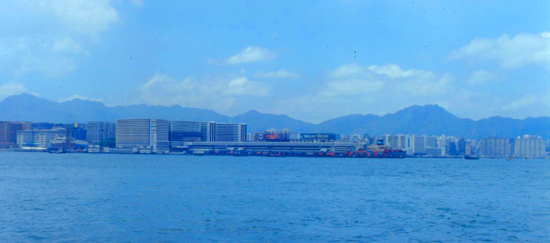 This is Kowloon, and immediately behind the new construction in the front (which is basically new hotels) is the main shopping district. |
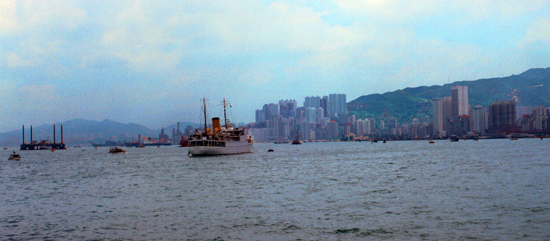 Here is another view of the Kowloon shore, and some of the shipping in the harbor. |
I Return to Visit "The Peak"
|
Established in 1934, the Chi Lin Nunnery is a very pretty temple complex with elegant wooden architecture and calming gardens. Part of the complex is the Nan Lian Garden, a public park built in the style of the Tang dynasty. Its scenic garden is meticulously landscaped over an area of 5 acres, in which every hill, rock, body of water, plant and timber structure has been placed according to specific rules and methods.
There are permanent exhibitions of Chinese timber architecture, rocks and potted plants, as well as numerous cafes and restaurants. It is an idyllic place with an interesting history as to where the funds for its construction came from.
There was apparently an immensely wealthy man, who amassed his fortune selling cold and pain remedies. The guide said that he had the feeling that even though his products did a lot of good, he had gotten more from his customers than they had gotten from him. Also, his name was not personally remembered.
So he decided to spend a large fraction of his fortune, just before his death, on a magnificent garden area. He bought a sizable chunk of Hong Kong hillside adjacent to the nunnery (some of it from them), and constructed thereon a veritable maze of buildings, including restaurants, shrines and some that serve no obvious purpose.
Connecting them are pathways and stairs, some hidden, some not. It is a wonderful place to roam around, quite away from the hustle and bustle of the city.
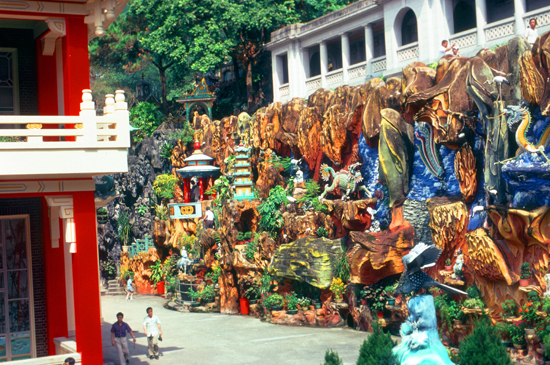 On one gigantic wall are all sorts of colorful carvings of animals and birds. Hidden in that wall, through the hole you can see to the left center, is a stairway that leads to the building above. There is an outside way, too, of course, but kids and other adventurous sorts take the more interesting approach. |
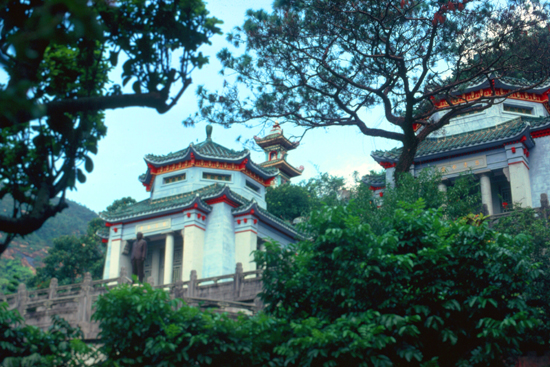 Up there is a statue of the famous man, along with his two family crypts. At least he's hardly ever lonely, what with all the people who come to visit. |
Of course, one can't get totally away from the souvenir stands and hawkers, nor is the source of the funds for the garden difficult to spot; there was one little shop selling all the products that the wealthy man's company still produces.
|
|
I have marked Victoria Peak (locally known simply as "The Peak") on the aerial view at right. It is the top of a hill on the western half of Hong Kong Island. It is also known as Mount Austin, and with an elevation of 1800 feet, it is the highest hill on Hong Kong island. The summit is occupied by a radio telecommunications facility and is closed to the public. However, the surrounding area of public parks and high-value residential land is the area that is normally meant by the name The Peak. It is a major tourist attraction that offers views of Central (the Hong Kong business district), Victoria Harbor, Lamma Island to the northwest, and the surrounding islands.
So the tour continued up the mountain to the spot that the tramway goes to. The route up was quite long, and in spots a little nerve-wracking. But the views were certainly worth it.
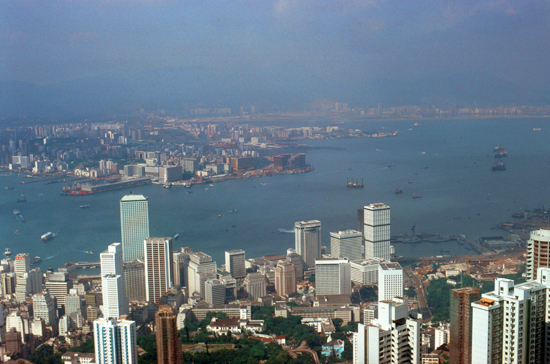 This is a beautiful panorama of the entire harbor area. From the right is the ocean outlet, some of the dock area, Hong Kong proper, and on the far side, Kowloon, the airport in the background and some residential areas. |
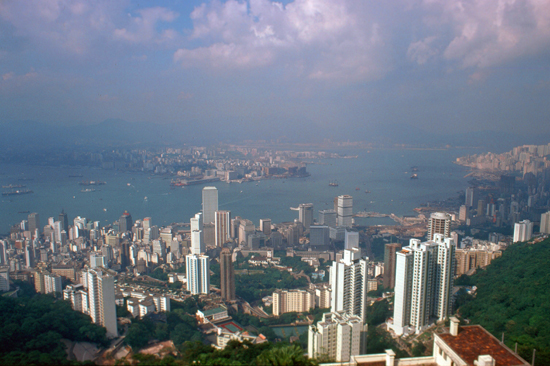 One of my favorites. In the late afternoon, a wider-angle view of the entire basin. Macau is way off to the left, about 20 miles away. |
As early as the 19th century, the Peak attracted prominent European residents because of its panoramic view over the city and its temperate climate compared to the sub-tropical climate in the rest of Hong Kong. The sixth Governor of Hong Kong, Sir Richard MacDonnell had a summer residence built on the Peak circa 1868.[1] Those that built houses named them whimsically, such as The Eyrie, and the Austin Arms. These original residents reached their homes by sedan chairs, which were carried up and down the steep slope of Victoria Peak. This limited development of the Peak until the opening of the Peak Tram funicular in 1888.
|
|
The boost to accessibility caused by the opening of the Peak Tram created demand for residences on the Peak. Between 1904 and 1930, the Peak Reservation Ordinance designated the Peak as an exclusive residential area reserved for non-Chinese. They also reserved the Peak Tram for the use of such passengers during peak periods. The Peak remains an upmarket residential area, although residency today is based on wealth.
With some five million visitors every year, the Peak is a major tourist attraction of Hong Kong. It has views of the city and its waterfront, and the ubiquitous coin-operated telescopes that the visitors can use to enjoy the cityscape. The number of visitors has led to the construction of numerous shopping facilities, and I recall seeing signs that some larger mall-like shopping center is due to be built around the tram station.
Shopping in Kowloon
Wandering around Hong Kong is really a delight, as there is so much to see and do, and so much to buy. Many of the stores are large, and most of them are quite modern, selling everything conceivable. I was in the market for a new watch, among other things, and I got a good deal on a new Seiko (the one I still have) at a little store just up the street and around the corner from the hotel. The price of the watch here in the United States at the time was just over $200; I was able to get it for just over $100.
The only thing I did not like about the shopping in Hong Kong is that, except in the major department stores, the price you pay is the price you can haggle for. Unfortunately, I am not a good haggler. If the price seems fair for what I am getting, I am content to pay it. But it does irk me that someone else can buy exactly the same thing at the same store for less. But that's the name of the game in the Orient (and elsewhere), although I can't imagine that ever catching on here. About the only thing that we have that is comparable to that is automobiles (and some appliance stores) where items have a list price, but the price you pay depends on how good a bargainer you are. I guess that's why I just loathe car shopping, because I always have the feeling that I'm getting taken.
Hong Kong has everything. Of course there are watches and jewelry, electronics, fabrics and clothes, furniture, and so on, things made right in the Colony, but there are also goods from all over the world, which is one reason why Hong Kong has the reputation that it does. One particularly interesting store was an outlet run by the Red Chinese. In this store, whose prices were posted and firm, are all manner of goods produced in China. One floor had silks, one had lacquerware, one furniture, one souvenirs, one food and one medicines. I purchased a number of articles, including the embroidered pictures of birds and flowers (one of which I have and two of which now belong to my sister and my mother). Almost everything I saw in the store was lovely, and most of it was very reasonable. They even take American Express (how capitalistic).
Just across the street from this store (the China Center) is one of the local eating places. One goes down a steep flight of stairs to a very, very crowded restaurant. There are no waitresses. One goes to a counter and orders from a menu posted above. There are some places to sit, but mostly the people have to stand. Among the delicacies served are sandwiches called "Big Macs", potatoes that are deep-fried, frozen concoctions made of milk, and so on. I understand that there is more than one of these in the Colony, and that they are very popular.
I was also able to mark out a jogging route that took me some three miles through the city. Although I don't particularly like to jog on city streets, this route wasn't too bad in the early evenings, and did use a fair number of sidewalks. Also a good way to see some parts of Kowloon that one wouldn't normally go to.
A Trip to the Border (with Red China, that is)
|
The nearest Chinese city to Hong Kong was then and still is Shenzhen. From 1953 through my visit to Hong Kong, Shenzhen was what the Chinese called a "market town". We would think of it perhaps as a county seat- a town with some minor government presence and a local trading center. As near as I can find out now, the population of Shenzhen in 1978 was 30,000; it was very much a rural small town. Our trip to the border took us from Kowloon up basically the only road into China- a road that now goes to the city of Shenzhen.
I recall vividly that the border was a fairly simple affair- a gatehouse and fence across the road- a road which was paved up to the border and hard packed dirt and gravel beyond it. Certainly there was no chance of actually seeing Shenzhen, as it was still miles away and a small town to boot.
We'll talk more about the border in a moment, but the story of Shenzhen really began the year after my visit, when China declared it to be a "special economic zone" (pretty much like Hong Kong is today, now that it's been ceded back to China). This meant that the city was exempted from many of the rules and regulations that governed the Chinese economy at the time; the city could function more like a free-trade zone.
This was, apparently, all that the city needed, for beginning in 1979, its growth was, to put it mildly, explosive. Just imagine if New Amsterdam had expanded into the New York City metropolitan area in the space of forty years; that's what's happened to Shenzhen. It is now an ultra-modern city of over 12 million people, and actually now part of an urbanized area that has over 60 million people! I am sure that were I to be standing today where I was standing at the border in 1978, not only would I be in the midst of a totally urban area, but I would easily be able to see the skyscrapers of Shenzhen. On the day I stood at the border, Shenzhen's tallest structure was five stories. In 2017, the Ping An Finance Center was constructed, the tallest of more than 500 highrises in the city. How tall? Well, it's currently China's second tallest building, and fourth tallest in the world. It has 117 floors and stands almost 2,000 feet high!
But let's get back to the drive up to the border. We passed through the center of the peninsula and then up the coast for a ways.
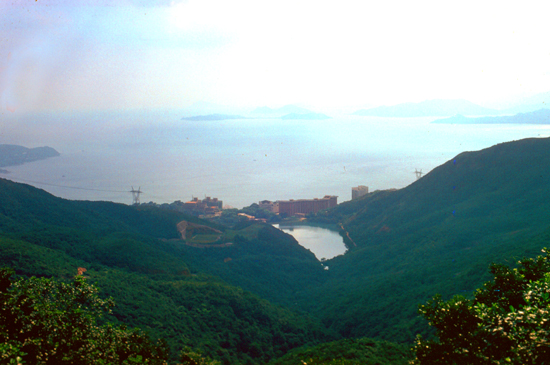 This is a view of a hotel/resort complex on this east side of the peninsula. The bus stopped at a small beach, where everybody got out and wandered around for a while, before continuing along its route north-northwest to the border. |
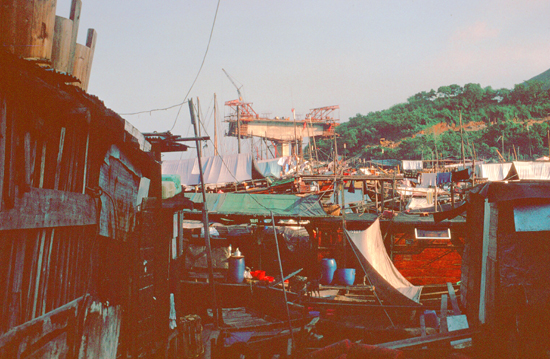 Along the coast, there are a number of people living on their fishing boats (I assume they are fishing boats), in very crowded conditions. Actually, on a good day it doesn't look too different than the haunts of the arty types on their boats in Marina del Rey, except that in California the boats are newer. In the background is some construction for a new bridge. |
|
|
Then the bus turned inland and to the northwest and began the ten-mile trip to the border.
We reached the border less than a half hour later. The tour actually stopped about a hundred feet from the border. The area at the border is park-like, with the buses parking some distance away and about a half-mile walk to where there were some exhibits and a vantage point for looking through the fencing into China. The whole thing reminded me of a touristy version of the DMZ in Korea, and I did take a number of pictures.
Before I talk about the pictures I took, let's take a look at the border as it is today (in 2019).
|
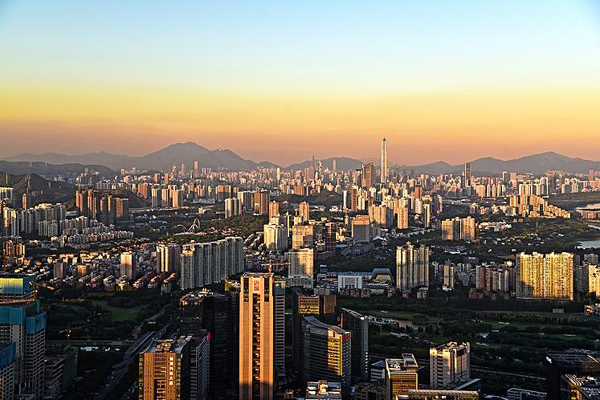 |
So, what about my pictures from the border and from the rest of the tour back to Kowloon? Well, that's an unfortunate story.
Just before arriving at the border, I'd put in a new roll of film, and by the time I got back to Kowloon had taken another twenty pictures or so. I left Hong Kong the next day and, when I checked in for my JAL flight back to the States, they were very strict about how much I could carry onto the plane. Since I had a couple of shopping bags of souvenirs to carry, that weren't wrapped so that they could be checked, like an idiot I checked my camera case (with camera inside). On arrival in San Francisco the next day, when the case was opened at Customs, I discovered that while the case had arrived the camera and one lens had not. The pictures that I had taken on that last part of the tour to the border were still inside the camera, and so they have been lost.
Hong Kong Postscript
The actual flight back was uneventful; there was a stop at the new airport in Tokyo, Narita. Steve had got me an invitation to the Sakura Lounge (the JAL First Class Lounge) and I spent the two hour layover waiting there. There was no stop in Honolulu on the way back. I arrived in San Francisco early in the morning, spent two hours in Customs and changing planes, and took United home to Chicago, arriving in the early evening. Jet lag caught up with me and I went right to sleep.
I'd lost my camera, and it took me a while to replace it. Fortunately, Cullinane didn't have be going anyplace really interesting (certainly not overseas) and so it wasn't until next summer that I got a new one. That's why the photoalbum ends here for this year.
You can use the links below to continue to another photo album page.
 |
August 19-23: A Visit to Bangkok |
 |
Return to Index for 1978 |